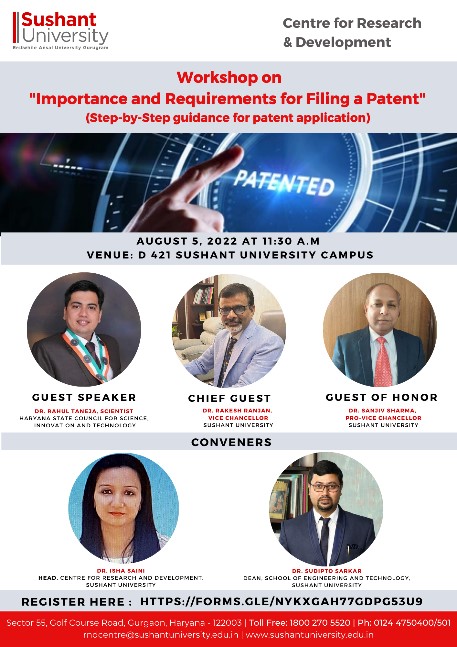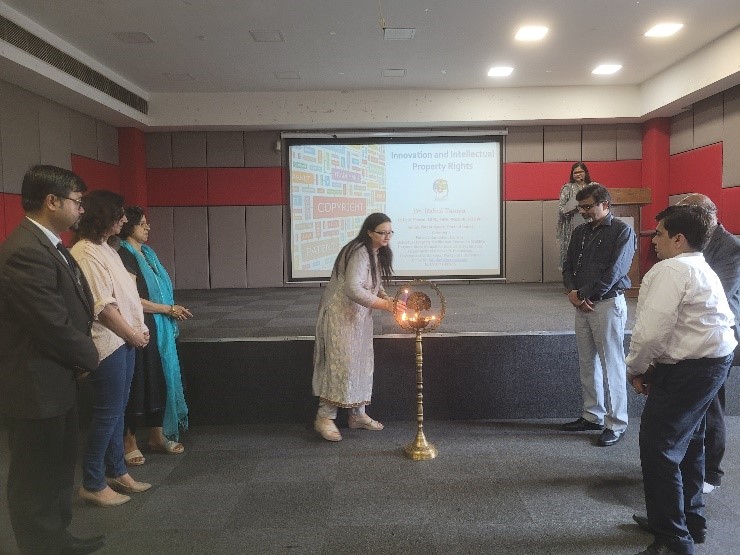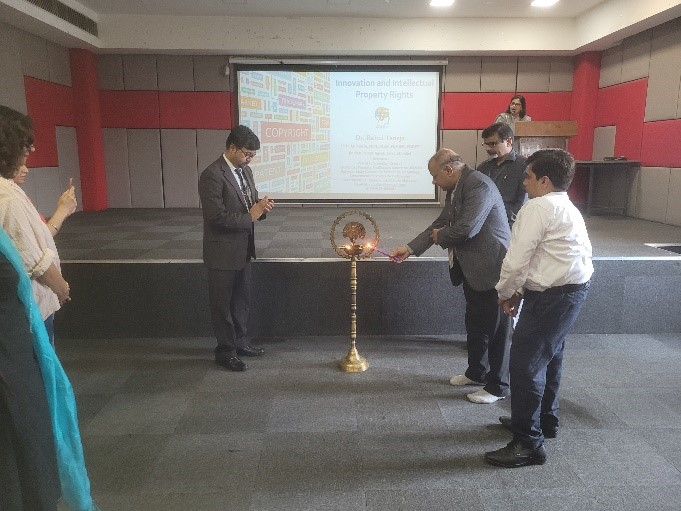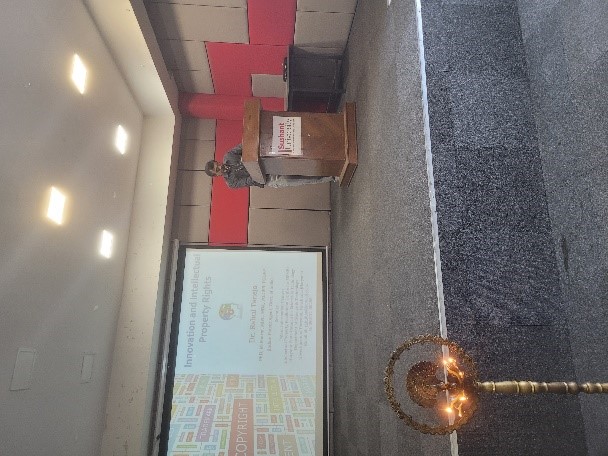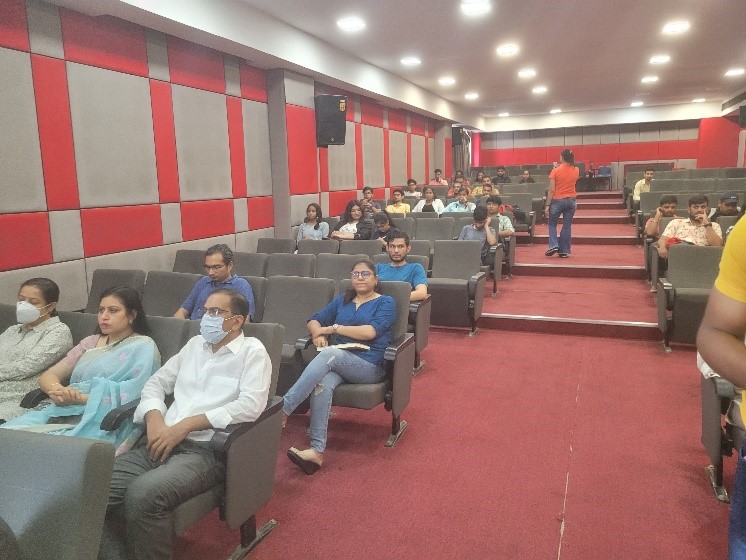Research and innovation are the crucial parameters for the growth and sustainability of a large economy and for upliftment of the society. The rapid changes in climate, technology and population dynamics are making a robust research system more important than ever. There are multiple ways by which research and innovation at universities and colleges in all academic disciplines across the country can be catalyzed. In this context, the Research & Development (R & D) Centre of Sushant University facilitates and encourages research culture among the faculty members and students. Its major role is to create a conducive environment for promotion of Research & Innovation activities in the university. It enables an affable environment for technological development and monitors the research activities of the University. It undertakes various initiatives such us, writing proposals to government and outside agencies for new projects, conducting technical programmes for faculty members and students, building multidisciplinary research teams across the Schools, generate funds through sponsored projects, facilitate internationalization in research etc. The R & D Centre aims to collaborate with other research organizations at national and international level and helps the University stand out in global map.
Roles & Responsibilities of R & D Centre
Research-Promotion-&-Incentive-Policy.pdf
Introduction
Rapid growth in scientific discovery is essential for economic and societal development. Apart from transmission of knowledge, conduct of research activities are central functions of Sushant University which is also evident from its mission -:
Overview
The senate of academic council of Sushant University hereby affirms the following principles concerning research:
Responsibilities
This section outlines the responsibilities of faculty members, research scholars and students in conduct of research. The main points are as follows:
Schemes related to promotion of research
To achieve missions of excellence in research, the SU institutes following awards and schemes
Seed funding for research: - Seed money of upto 3 Lakhs to faculty members for pursuing their research work. This will be done by submitting the proposal to VC through SRC (School Research Committee) who will further constitute a committee for evaluating the proposal. This proposal can be submitted throughout the year. The proposal should include – need of the work, objective, financial details, methodology etc.
Research Paper Awards: -
Best Researcher Awards: -
(Area funding) Will be given to faculty member who have got highest funding in the last completed academic year. This includes an award (gift vouchers worth rupees 30,000/-) apart from due credits in the performance appraisal system. The faculty member will also be felicitated with a citation and memento.
(Area recognition) Will be given to faculty member/s who have earned any National or International recognition (Awards/Fellowship). This includes an award (gift vouchers worth rupees 30,000/-) apart from due credits in the performance appraisal system. The faculty member will also be felicitated with a citation and memento.
GUIDELINES FOR ETHICS IN RESEARCH
Research at any institution should bring innovation, creativity and creation of new knowledge/ideas without compromising on the ethical practices/academic integrity. Research that is being carried out should have societal/environmental impact and should not be done just for the sake of publishing. Recently, there has been an increase in number of publications in dubious/predatory journals in India. Hence, there is a need to frame these guidelines to make the researchers aware of the ethical practices to be followed while doing research at Sushant University
Guidelines suggested by several Government agencies (Sources 1 & 2) have provided a basis for the preparation of the below guidelines for the Sushant University.
While conducting research, whether independently or jointly, it is necessary to ensure that data collected (including raw data) are reliable, properly recorded and dated, and carefully stored. Fabrication and falsification of data, even data that may be perceived to be of relatively lower importance to the research outcome, clearly constitute scientific misconduct. The procedure followed should be described in sufficient detail to permit independent verification. Selective use of data without scientifically valid reasons is unacceptable. Not following the above guidelines on data collection can lead to scientific misconduct.
Scientific misconduct is the violation of the codes of scholarly conduct and ethical behaviour in the publication of professional scientific research. These include all acts from the initiation of an idea, its experimental verification, accuracy of results, accurate reporting without resorting to any malpractice in the presentation of data/images, due acknowledgement of all sources of information and people. Scientific misconduct(s) can be of various types and can occur at various stages-from the initiation of the scientific study to publications and/or patent generation. While these involve violation of generally accepted research practices, inadvertent errors or genuine differences in interpretation or judgement in assessment of the results may not constitute scientific misconduct. Scientific misconduct may be categorized into the following:
2.1 Laboratory Records: It is vital to keep proper records of each experiment, details of materials obtained from varied sources and how they were used, procedures, analysis and other related material. Graphs and printouts from instruments should be numbered and filed appropriately. If any software is used for handling and analysing the data, its name, version and other details should be recorded. The laboratory records of experiments carried out using a publicly funded institution should carry every single detail of the experiment. Such records are the property of the laboratory and are to be kept for archival and later retrieval purposes; a copy will of course be that of the researcher and can be used by anyone till after a defined moratorium period of 18 months. Due permission and acknowledgement of the researchers who carried out the experiments is essential at all times.
2.2 Consultancy work: External consultation should be done with explicit permission from the Institutional Head where the scientist/technologist works. At the same time, permissions, if denied, should be justified and the reasons thereof be formally recorded. If the facilities of the institution are used, the details should be declared and recorded with due confidentiality in terms of the interest of the client. A clear statement on the resources to be used and finances that would accrue to the consultant and the institution should be recorded ab initio.
2.3 Project grants and awards Project proposals, as well as selection of candidates for awards and fellowships, are usually evaluated by committees with the help of peer review. It is important that the highest ethical standards are observed by committee members. Both positive and negative bias, due to one's personal position, role or involvement, are inappropriate.
3.1 Authorship: The authorship of scientific publications is a very important issue since it is the way in which scientists receive credit for their contributions. All listed authors of a publication should have contributed significantly to it. It is inappropriate to offer 'guest authorship' to anyone who has not made a significant contribution. Likewise, it is wrong to exclude from authorship anyone who deserves to be an author. It is unethical to include anyone as an author of a paper without their knowledge and clear consent. The order of authorship is very important. In this matter, conventions vary in different fields, and in general, one should be consistent with the conventions in the field and the criteria laid down by the journal to which the work is submitted.
3.2 Plagiarism: The Oxford English Dictionary defines plagiarism as 'the practice of taking someone else's work or ideas and passing them off as one's own'. In the context of scientific research, it can involve unattributed lifting of textual material or scientific ideas or actual research results. The most extreme example would be a deliberate attempt to pass off someone else's entire research project as one's own. However, it can also involve (deliberate or unintentional) incorporation of some ideas or results of other researchers, without proper attribution, within one's own research publication. Though the degree of severity can vary, plagiarism always amounts to ethical misconduct. Use of someone else's work in one's own is not by itself unethical. A limited amount of textual material in someone else's paper can be copied if it is clearly marked as a quote (typically by enclosing it within quotation marks) and the source is explicitly cited where the quote starts or ends. Alternatively, text may be paraphrased with a general indication of where the concepts originated. Occasional re-ordering or substituting of words is not sufficient to count as paraphrasing: the recommended procedure is to read and understand the source material, and then to put it away and express the idea in one's own words. Besides textual material, incorporation of ideas, figures, graphs, etc. from other sources in a manner that conveys a false impression that they are original amounts to plagiarism. Taking one's own published results and reproducing them in another published work as if they were new is 'self-plagiarism'. 'Duplicate publication' – submitting the same research results to two or more journals and treating them as separate publications – is also a form of self-plagiarism and must be avoided. Plagiarism is an issue not only for publications in journals but also for reports, textbooks, monographs and grant proposals. The above considerations apply equally in all these cases.
3.3 Redundant /Salami Publications: Resorting to ‘Redundant’ publications for artificial enhancement of the number of publications is also a serious act of misconduct. Also, the simultaneous submission of the same manuscript in multiple journals, in order to have one of them accepts it, is gross misconduct.
3.4 Responsibility of Reviewers: Scientists who are asked to review a manuscript or a research proposal have the responsibility to ensure they do not misuse their advance access to the information and ideas in these documents. The use of such advance access to publish a competing work, or to carry out research that pre-empts a proposed project is unethical.
3.5 Peer review: Scientists often act as referees in review of manuscripts submitted for publication as well as project proposals submitted for financial support. This exercise should be carried out with the maximum possible objectivity. It is essential to avoid personal bias and/or conflicts of interest.
A University level Committee on Ethics called the Ethical Committee, involving people at different levels (scientific and administrative) have been established. Scientific misconducts would be investigated by the Ethical committee and the recommendations would be made to the Vice-Chancellor by the chairperson of the committee.
References
Sources
| Name of the Patenter | Title of the patent | Year of Publication/Award of patent |
| Dr. Neha Gupta | A system for biodiesel production from Rice Bran oil by transesterification and Process Optimization |
2017 |
| Dr. Latika | A system and method for providing of online first and guidance during Ocular emergency situations |
2020 |
| Dr. Neha Gupta | A system for generation and optimization of Bioenergy in diesel generator for rural electrification using ANN |
2019 |
| Dr. Neha Gupta | A System of Round Robin, Active Monitoring, Throttled, DSBP Selection Data Center Simulation over Cloud for Centralized and Distributed Data Center by using Load Balancing Techniques |
2020 |
| Dr. Arti Vaish | System of Agriculture Robot for Automatic Spraying Seeding, Harvesting and Monitoring Crop |
2019 |
| Dr. Arti Vaish | Refrigeration System of Clay Cool Chamber Using Solar Energy |
2019 |
| Dr. Arti Vaish | Improved Hand Operated Embroidery Tool for Easy Operation | 2020 |
| Dr. Arti Vaish | Humanoid robot for energy efficiency movement with optimized control | 2020 |
| Dr. Arti Vaish | Effective Management Analysis of Signal Coverage and Novel Design of Triangular Patch Antenna for Q | 2020 |
| Dr. Arti Vaish | Low cost voice enabled multisense smart stick for visually impaired person | 2020 |
| Dr. Arti Vaish | A smart adaptive neural fuzzy interface supervised active power filter for Harmonic Distortion Control in Ac Power driven IOT devices | 2020 |
| Dr. Arti Vaish | Low cost GSM based smart Irrigation Switch with three phase to single-phase selector | 2020 |
| Dr. Arti Vaish | A predictive accident prevention system for vehicles safety on sharp turns on hilly roads | 2020 |
| Dr. Arti Vaish | CNG/ Natural gas kit design for two wheelers | 2020 |
| Name of the Patenter | Title of the patent | Year of Publication/Award of patent |
|
Dr Neha Gupta, Dr. Latika |
Blockchain-based solution to combat bed allocation problem in an epidemic outbreak |
2020-21 |
|
Dr. Aarti Vaish |
APTD- Waste Recyclable Material Management System: Automatic Process And Methods Management System For Power Generation Distribution Equipment Related Waste Recyclable Material Converted Into Valuable Added Products. |
2020-21 |
|
Dr. Aarti Vaish, Mr. Antim Dev Mishra |
A Low cost Indian Currency Identifier for Visually Impaired Person |
2020-21 |
|
Dr. Neha Gupta |
A Custom Lookup Creation Sobject |
2020-21 |
|
Dr Garima Bakshi |
An accurate hiearchical fuzzy tool for the detection of autism |
2020-21 |
|
Dr Garima Bakshi |
IOT based healthcare queue management system |
2020-21 |
|
Dr Garima Bakshi |
Design and deveopment of microstrip patch antenna for optimized radiation |
2020-21 |
|
MS. CHANDANA PAUL, Ms Anshu Rawal, Ms. Anjali Khurana |
: FRANGIPANI UPHOLSTERY FRESHENER |
2020-21 |
|
Dr. Kanika Sachdeva |
Method for predicting Investment behaviour by analysing an effect of a global event on a Stock |
2020-21 |
| Name of the teacher awarded national/ international fellowship/financial support | Name of the award/fellowship | Year of Award | Awarding Agency |
| Dr. Monika Khurana | DST -SERB Young Scientist Award | 2015-2018 | SERB, Department of Science and Technology |
| Dr. Isha Saini | DST-SERB International Travel fellowship |
2018-2019 | SERB, Department of Science and Technology |
| Dr Latika and Dr Neha Gupta | IIT Delhi - Unnat Bharat Abhiyan | 2018-19 | Unnat Bharat Abhiyan |
| Name of the consultant | Name of consultancy project |
| Sushant School of Art and Architecture, facilitated by Dr. Vibhuti Sachdev | Conservation Design Development of Quila Pratapner, Etawah, U.P |
| Sushant School of Art and Architecture, facilitated by Dr. Parul Munjal | Conservation and Interpretation of Jean Etienne’s Tomb, Mohyal Colony, Jharsa, Gurgaon |
| Sushant School of Art and Architecture, facilitated by Bhawna Dandona | Documentation of Mass Housing New Delhi |
| Sushant School of Art and Architecture, facilitated by Dr. Parul Munjal and Himanshu Sanghani | Analysis and Design Proposal for Intervention, RMTI Campus, Navjyoti India Foundation, Gurgaon (in process) |
| Sushant School of Art and Architecture, facilitated by Dr. Parul Munjal and Pooja Lalit Kumar | Sadar Bazaar Redevelopment |
The instruments available at Sushant University are being used by members of the University as well as researchers from other institutes also.
List of Instrumentation facilities available:
UV-Visible spectrophotometer,
Fourier Transform Infrared Spectrophotometer,
Centrifuge machine,
Ultrasonicator,
Distillation system,
Vertical Autoclave,
Laminar air Flow,
BOD INCUBATOR,
Hot Air Oven,
Muffle Furnace,
Zone reader,
Colony Counter,
Photoflourimeter,
Auto pH meter,
Bottle filling machine
Anion-Cation Exchanger
Conductivity meter,
Vacuum Pump,
Bulk Density Apparatus,
Dissolution rate test apparatus
Digital Sieve Shaker
Water Bath
Ball Mill
